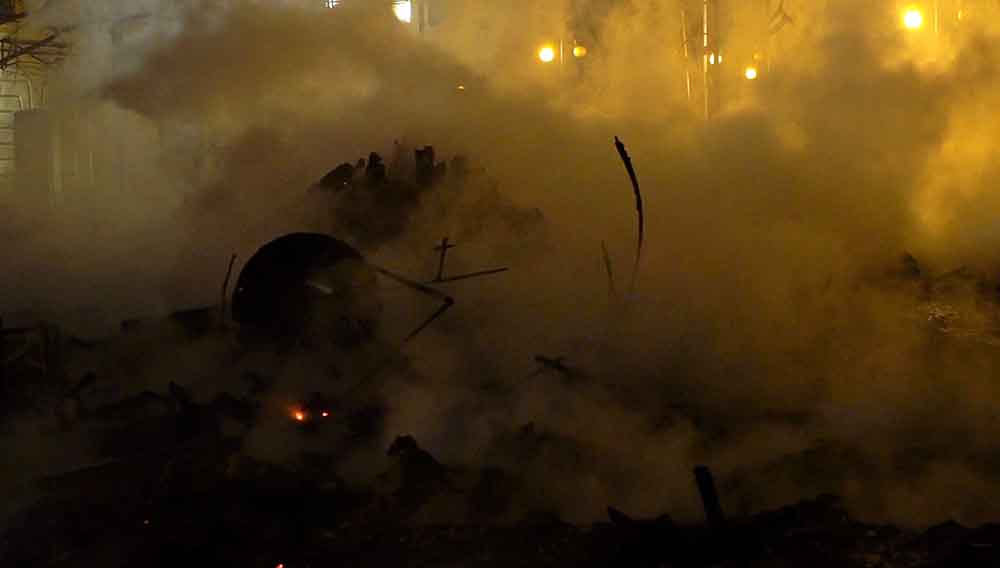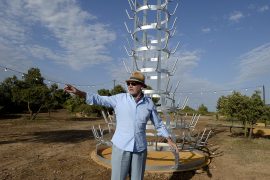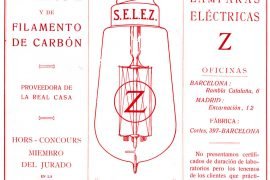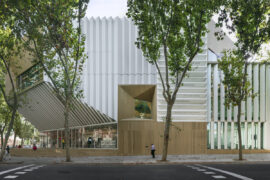[dropcap letter=”W”]
hat happens to the ashes of the Falles in Valencia once they have been feted and burned, when the public ritual is left behind? What volume do they take? What do they do with them? Where do they go? Can that pile of waste that ends up as ash reduce the loss of random beauty, of a capricious movement or even a harmonic state? This is the void that artist Anna Malagrida (Barcelona, 1970) explores in her exhibition open at the Institut Valencià d’Art Modern (IVAM)—the Valencian Institute of Modern Art—until February 24, 2019. Symptomatically titled ‘El pes de les cendres’— The Weight of the Ashes —it is being exhibited in Gallery 6, which is a difficult space, a critical conditioner. It has an intricate shape, with a staircase in the middle of the room that connects the two floors. It is precisely this space that Malagrida has conceived the exhibition for, and is made up of videos shot with a static camera creating two absolutely different atmospheres on the first and second floors.
The artist addresses what nobody focuses on. After the extravaganza of the Falles—during which elaborate cardboard and paper-mâché artistic monuments are built and then burnt—the flames go out and the workers begin the labour of taking the ashes to the waste dump. She goes with her videocam and records fixed shots of an enormous allegorical force—obviously, everything had to be recorded on a single night. This aspiration to suggesting other meanings and other possibilities beyond the fact itself, permeates the whole exhibition with calculated ambiguity, a touch enigmatic.
After all, the 200-truck corridor is also part of the Falles, and once the last flicker has been smothered, they take the path to the dump, loaded with waste and ash
 On the first floor, the still virulent flames of the Falles, with small detonations from burning embers, transport us to the prototype image of street riots—who knows whether influenced by the disturbances in the banlieues in Paris, a city Malagrida knows well because it is where she lives part of her profession. As a result of the fixed shots, the videos that hang from the walls provide moving pictures, as if the artist wishes to make clear her dual facets: she usually works with both photographs and videos. Live flames or smoke from the remains of the figures turned into ash, a bewildering gaseous state that would never be associated in any way with the Falles, giving an air of tension and desolation, of a pressing conflict that might at any time explode again, or die out completely.
On the first floor, the still virulent flames of the Falles, with small detonations from burning embers, transport us to the prototype image of street riots—who knows whether influenced by the disturbances in the banlieues in Paris, a city Malagrida knows well because it is where she lives part of her profession. As a result of the fixed shots, the videos that hang from the walls provide moving pictures, as if the artist wishes to make clear her dual facets: she usually works with both photographs and videos. Live flames or smoke from the remains of the figures turned into ash, a bewildering gaseous state that would never be associated in any way with the Falles, giving an air of tension and desolation, of a pressing conflict that might at any time explode again, or die out completely.
Being especially interested in those elements that generate the identity of cities, the artist intends to stir up the ashes, to accompany them to the dump, to illuminate an area in the shadows of the magic ritual, but which inevitably also forms part of the Falles. After all, the 200-truck corridor is also part of these, and once the last flicker has been smothered, they take the path to the dump, loaded with waste and ash.

The path to the dump takes us up to the second floor. We leave behind the conflagration and darkness that opens the exhibition and we pass into a kind of white, aseptic, almost heavenly room, which conveys a peace that is still intriguing, especially if we compare with the pictures we started with. There is some kind of harmony, with nice innuendos which Malagrida has managed to find in the heap of ash and remains of the Falles that no longer seems just a pile in a dump. A video shows how a worker sweeps the waste in front of a mound of ash until another truck unloads its cargo and a cloud of dust enshrouds him, though he does not stop sweeping. This is a magical moment. And a couple of other videos are also remarkable, where by using the angle that the wall forms, show the process of transformation of the debris into sand and how it ends up forming new sinuous piles, in a kind of eurhythmic dance.
The idea of the process of transformation of the materials ties together the whole of Malagrida’s proposition, which one might say has the visitor pass through different phases of matter. There is a play on the element of dust, which refers to Man Ray’s celebrated Elevage de la poussière. In 1920, Man Ray visited Marcel Duchamp’s studio and photographed a glass plate on which dust had built up over the months. Man Ray’s photo, at maximum exposure, captures several unusual shapes on the glass. The Barcelona artist pursues the same intention by focusing closely on a machine cutting the polystyrene that will form part of the construction of future figures in the Falles. These videos adopt a contemplative bias and accompany the almost astonishing harmony that comes out of a workshop or a dump. From that photograph, Duchamp extracts the concept of “inframince”—the infra-tenuous —that ponders how to exude the art of the imperceptible, the invisible. Malagrida stretches and plays with the infra-tenuous, from a singular point of view, seeking to illuminate tiny details, impressions that go unnoticed because they are not part of the public ceremony, but which provide explanations for the many palpitations and paradoxes of the city itself.


















